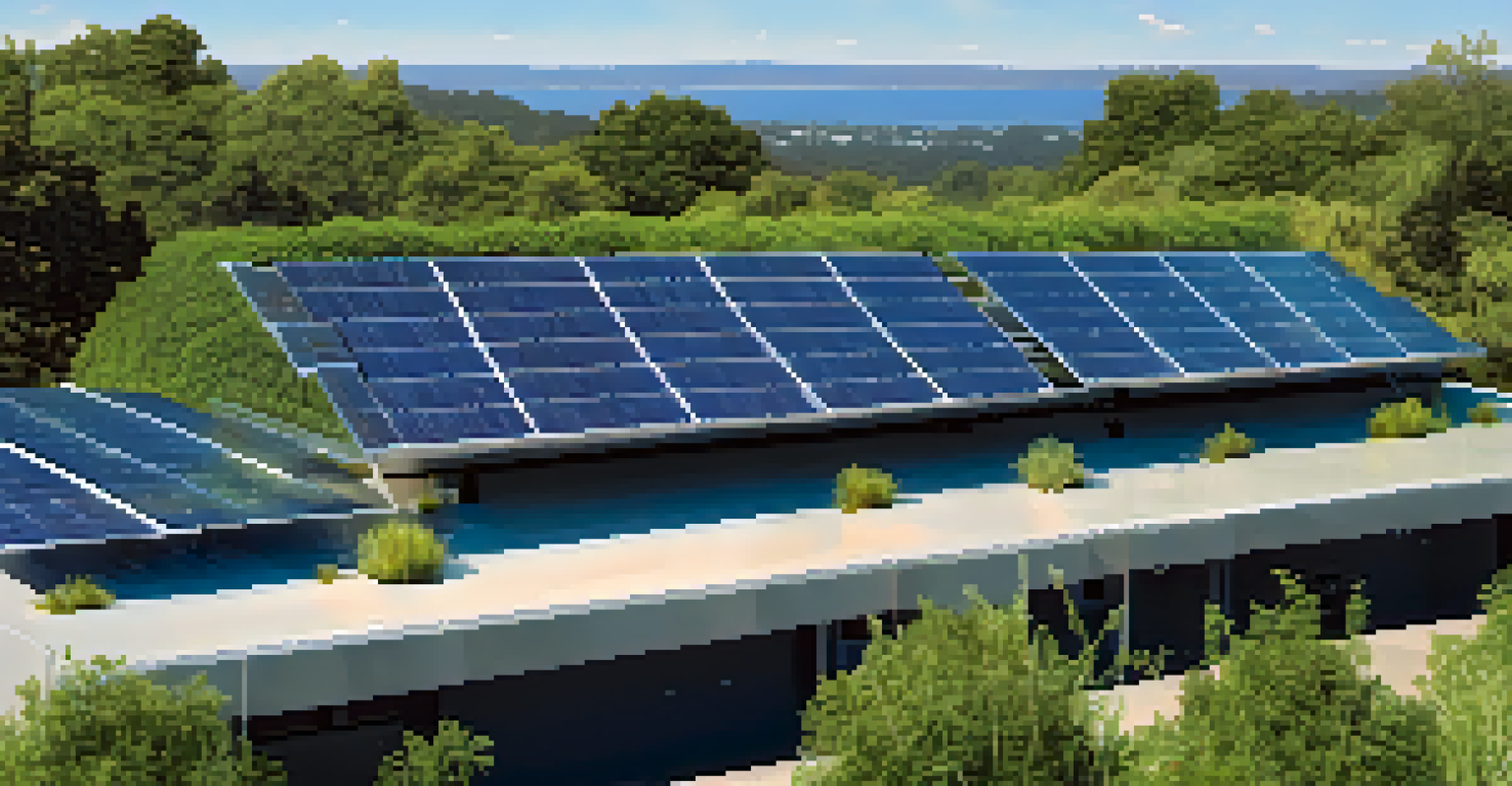Understanding Energy Consumption Patterns with Smart Tech

The Rise of Smart Technology in Energy Management
In recent years, smart technology has become a game-changer in energy management. Devices like smart thermostats and energy monitors not only enhance convenience but also provide valuable insights into how energy is consumed. By connecting these devices to the internet, users can track their energy usage in real-time, making informed decisions about consumption patterns.
The great thing about smart technology is that it makes life easier, more efficient, and more sustainable without adding complexity.
These innovations allow homeowners and businesses to understand their energy habits better, leading to improved efficiency and reduced costs. For instance, a smart thermostat can learn your schedule and adjust heating or cooling accordingly, thereby conserving energy when it's not needed. This not only saves money but also contributes to a more sustainable future by reducing overall energy demand.
As more individuals embrace these technologies, the collective impact on energy consumption becomes significant. By harnessing the power of smart tech, we can create a more informed society that prioritizes energy efficiency and sustainability. This shift towards smarter energy management is not just a trend; it's becoming an essential practice for modern living.
How Smart Devices Track Energy Usage
Smart devices employ various sensors and algorithms to monitor energy consumption. For example, smart plugs can track the energy usage of specific appliances, providing insights into which devices consume the most power. By analyzing this data, users can identify energy hogs and make changes to reduce consumption, such as unplugging devices when not in use.

Some smart meters even offer detailed reports, allowing users to see their energy usage patterns over time. This historical data can reveal trends, such as higher consumption during specific hours, encouraging users to shift their habits. By understanding these patterns, individuals can take proactive steps to optimize their energy use, leading to both cost savings and environmental benefits.
Smart Tech Enhances Energy Efficiency
Smart devices like thermostats and plugs help users track and manage their energy consumption, leading to cost savings and reduced environmental impact.
Additionally, many smart devices can be integrated with mobile apps, providing users with a user-friendly interface to monitor their energy consumption. This accessibility empowers users to take control of their energy habits, making informed decisions that align with their sustainability goals.
The Benefits of Understanding Energy Consumption Patterns
Understanding energy consumption patterns is crucial for both financial and environmental reasons. When individuals and organizations are aware of their energy usage, they can identify opportunities to cut costs significantly. For instance, if a business realizes that certain machinery is running overtime, they can adjust schedules to minimize energy waste and save money.
In the age of smart technology, we have the power to monitor our energy use effectively and make informed choices that benefit both our wallets and the planet.
Moreover, recognizing consumption patterns helps in reducing carbon footprints. By using smart technology to monitor and manage energy effectively, we can all contribute to a greener planet. For example, shifting energy use to off-peak hours can decrease the demand on power plants, leading to lower emissions and less strain on the grid.
Additionally, these insights can inform future energy strategies. Whether it’s implementing more energy-efficient appliances or investing in renewable energy sources, understanding current patterns provides a roadmap for sustainable energy practices. This proactive approach fosters a culture of conservation and responsibility.
Integrating Smart Tech with Renewable Energy Sources
The integration of smart technology with renewable energy sources is a powerful combination that enhances sustainability. For instance, solar panels can be paired with smart inverters that optimize energy usage based on real-time data. This not only maximizes energy production but also ensures that consumers are using energy when it's most cost-effective.
By using smart technology to manage renewable energy, homeowners can store excess energy generated during peak production times for use when demand is higher. This capability not only increases energy independence but also contributes to a more resilient energy grid. As we move towards a more sustainable future, integrating these technologies becomes increasingly important.
Data Analytics Drives Energy Insights
By utilizing data analytics, businesses can identify consumption patterns and anomalies, optimizing energy use and enhancing operational efficiency.
Furthermore, smart technology can facilitate energy trading among users, allowing individuals with excess renewable energy to sell it to others. This creates a decentralized energy ecosystem that empowers consumers and promotes the use of clean energy sources. The synergy between smart tech and renewables is essential for achieving long-term sustainability goals.
Challenges in Adopting Smart Energy Solutions
While the benefits of smart energy solutions are clear, there are challenges that can hinder widespread adoption. One significant barrier is the upfront cost of purchasing smart devices and systems. For many households and small businesses, these costs can seem prohibitive despite the long-term savings they may offer.
Additionally, there can be a lack of awareness or understanding of how to effectively use smart technology. Many consumers may not realize the potential savings or environmental benefits, leading to a reluctance to invest in these solutions. Education and outreach are essential to inform the public about the advantages of smart energy management.
Lastly, technological compatibility can be an issue. With a myriad of devices on the market, ensuring that they work seamlessly together can be a challenge. As technology continues to evolve, developers must focus on creating standardized systems that enhance user experience and promote easier integration.
The Role of Data Analytics in Energy Consumption
Data analytics plays a pivotal role in understanding and optimizing energy consumption patterns. By analyzing vast amounts of data collected from smart devices, companies can uncover insights that drive energy efficiency. For example, machine learning algorithms can predict energy usage trends, allowing businesses to anticipate demand and adjust their operations accordingly.
Moreover, data analytics helps identify anomalies in energy consumption, which can signify issues such as equipment malfunctions or inefficiencies. By addressing these problems promptly, organizations can save on energy costs and improve overall operational efficiency. This proactive approach not only enhances profitability but also contributes to a more sustainable energy model.
Renewables and Smart Tech Synergy
Integrating smart technology with renewable energy sources promotes sustainability and empowers consumers to manage their energy more effectively.
As data analytics technology becomes more sophisticated, it will continue to transform the energy landscape. The ability to harness and interpret data effectively empowers both consumers and businesses to make informed decisions about energy use, paving the way for a more sustainable future.
The Future of Smart Energy Management
The future of smart energy management looks promising, with advancements in technology paving the way for more efficient consumption. As the Internet of Things (IoT) continues to expand, we can expect even greater integration between devices and energy sources. This interconnectedness will enhance our ability to monitor and manage energy consumption in real-time, leading to smarter decisions.
Moreover, developments in artificial intelligence (AI) will further enhance energy management systems. AI can analyze patterns and predict energy needs more accurately, allowing for optimized energy distribution and usage. This not only benefits consumers but also supports utility companies in managing demand more effectively.

As we embrace these innovations, the potential for reducing energy waste and promoting sustainability will grow exponentially. The shift towards smart energy management is not just a trend; it represents a fundamental change in how we approach energy consumption and conservation. By adopting these technologies, we can work towards a more sustainable and energy-efficient future for all.